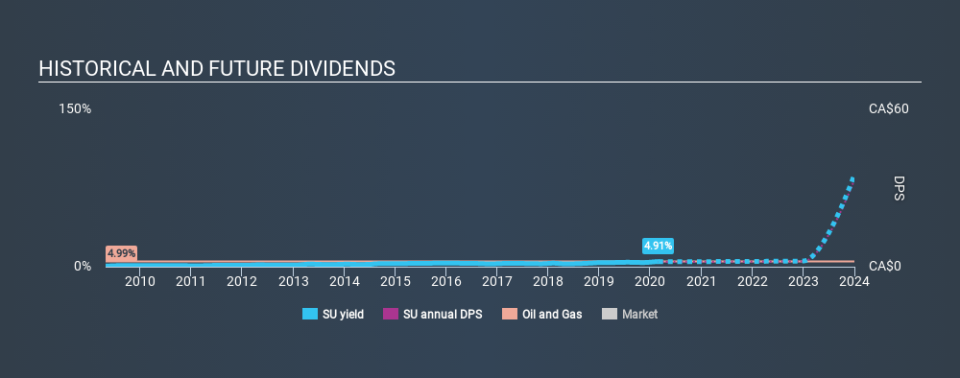Why It Might Not Make Sense To Buy Suncor Energy Inc. (TSE:SU) For Its Upcoming Dividend

Regular readers will know that we love our dividends at Simply Wall St, which is why it's exciting to see Suncor Energy Inc. (TSE:SU) is about to trade ex-dividend in the next 4 days. This means that investors who purchase shares on or after the 3rd of March will not receive the dividend, which will be paid on the 25th of March.
Suncor Energy's next dividend payment will be CA$0.47 per share. Last year, in total, the company distributed CA$1.86 to shareholders. Based on the last year's worth of payments, Suncor Energy has a trailing yield of 4.9% on the current stock price of CA$37.88. If you buy this business for its dividend, you should have an idea of whether Suncor Energy's dividend is reliable and sustainable. That's why we should always check whether the dividend payments appear sustainable, and if the company is growing.
See our latest analysis for Suncor Energy
Dividends are usually paid out of company profits, so if a company pays out more than it earned then its dividend is usually at greater risk of being cut. Last year, Suncor Energy paid out 90% of its income as dividends, which is above a level that we're comfortable with, especially if the company needs to reinvest in its business. Yet cash flows are even more important than profits for assessing a dividend, so we need to see if the company generated enough cash to pay its distribution. Over the last year it paid out 54% of its free cash flow as dividends, within the usual range for most companies.
It's good to see that while Suncor Energy's dividends were not well covered by profits, at least they are affordable from a cash perspective. Still, if the company continues paying out such a high percentage of its profits, the dividend could be at risk if business turns sour.
Click here to see the company's payout ratio, plus analyst estimates of its future dividends.
Have Earnings And Dividends Been Growing?
Stocks with flat earnings can still be attractive dividend payers, but it is important to be more conservative with your approach and demand a greater margin for safety when it comes to dividend sustainability. If earnings fall far enough, the company could be forced to cut its dividend. That explains why we're not overly excited about Suncor Energy's flat earnings over the past five years. Better than seeing them fall off a cliff, for sure, but the best dividend stocks grow their earnings meaningfully over the long run.
The main way most investors will assess a company's dividend prospects is by checking the historical rate of dividend growth. Suncor Energy has delivered 25% dividend growth per year on average over the past ten years.
The Bottom Line
Is Suncor Energy worth buying for its dividend? Flat earnings per share and a high payout ratio are not what we like to see, although at least it paid out a lower percentage of its free cash flow. With the way things are shaping up from a dividend perspective, we'd be inclined to steer clear of Suncor Energy.
Curious what other investors think of Suncor Energy? See what analysts are forecasting, with this visualisation of its historical and future estimated earnings and cash flow.
We wouldn't recommend just buying the first dividend stock you see, though. Here's a list of interesting dividend stocks with a greater than 2% yield and an upcoming dividend.
If you spot an error that warrants correction, please contact the editor at editorial-team@simplywallst.com. This article by Simply Wall St is general in nature. It does not constitute a recommendation to buy or sell any stock, and does not take account of your objectives, or your financial situation. Simply Wall St has no position in the stocks mentioned.
We aim to bring you long-term focused research analysis driven by fundamental data. Note that our analysis may not factor in the latest price-sensitive company announcements or qualitative material. Thank you for reading.

 Yahoo Finance
Yahoo Finance 
